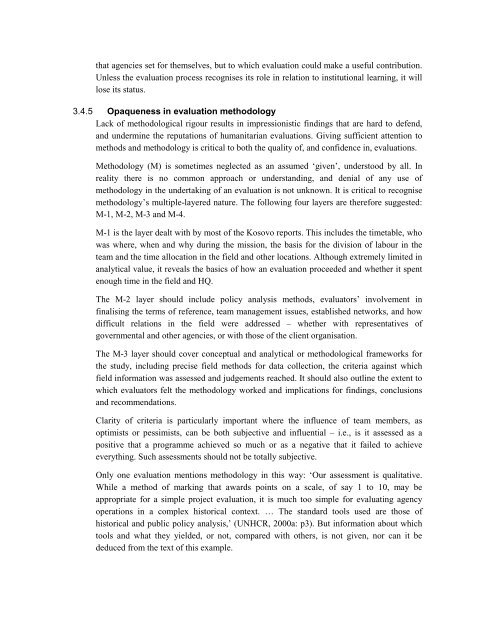Download PDF - ReliefWeb
Download PDF - ReliefWeb
Download PDF - ReliefWeb
Create successful ePaper yourself
Turn your PDF publications into a flip-book with our unique Google optimized e-Paper software.
that agencies set for themselves, but to which evaluation could make a useful contribution.<br />
Unless the evaluation process recognises its role in relation to institutional learning, it will<br />
lose its status.<br />
3.4.5 Opaqueness in evaluation methodology<br />
Lack of methodological rigour results in impressionistic findings that are hard to defend,<br />
and undermine the reputations of humanitarian evaluations. Giving sufficient attention to<br />
methods and methodology is critical to both the quality of, and confidence in, evaluations.<br />
Methodology (M) is sometimes neglected as an assumed ‘given’, understood by all. In<br />
reality there is no common approach or understanding, and denial of any use of<br />
methodology in the undertaking of an evaluation is not unknown. It is critical to recognise<br />
methodology’s multiple-layered nature. The following four layers are therefore suggested:<br />
M-1, M-2, M-3 and M-4.<br />
M-1 is the layer dealt with by most of the Kosovo reports. This includes the timetable, who<br />
was where, when and why during the mission, the basis for the division of labour in the<br />
team and the time allocation in the field and other locations. Although extremely limited in<br />
analytical value, it reveals the basics of how an evaluation proceeded and whether it spent<br />
enough time in the field and HQ.<br />
The M-2 layer should include policy analysis methods, evaluators’ involvement in<br />
finalising the terms of reference, team management issues, established networks, and how<br />
difficult relations in the field were addressed – whether with representatives of<br />
governmental and other agencies, or with those of the client organisation.<br />
The M-3 layer should cover conceptual and analytical or methodological frameworks for<br />
the study, including precise field methods for data collection, the criteria against which<br />
field information was assessed and judgements reached. It should also outline the extent to<br />
which evaluators felt the methodology worked and implications for findings, conclusions<br />
and recommendations.<br />
Clarity of criteria is particularly important where the influence of team members, as<br />
optimists or pessimists, can be both subjective and influential – i.e., is it assessed as a<br />
positive that a programme achieved so much or as a negative that it failed to achieve<br />
everything. Such assessments should not be totally subjective.<br />
Only one evaluation mentions methodology in this way: ‘Our assessment is qualitative.<br />
While a method of marking that awards points on a scale, of say 1 to 10, may be<br />
appropriate for a simple project evaluation, it is much too simple for evaluating agency<br />
operations in a complex historical context. … The standard tools used are those of<br />
historical and public policy analysis,’ (UNHCR, 2000a: p3). But information about which<br />
tools and what they yielded, or not, compared with others, is not given, nor can it be<br />
deduced from the text of this example.
















![CynefinFramework final [Read-Only]](https://img.yumpu.com/19017304/1/190x135/cynefinframework-final-read-only.jpg?quality=85)